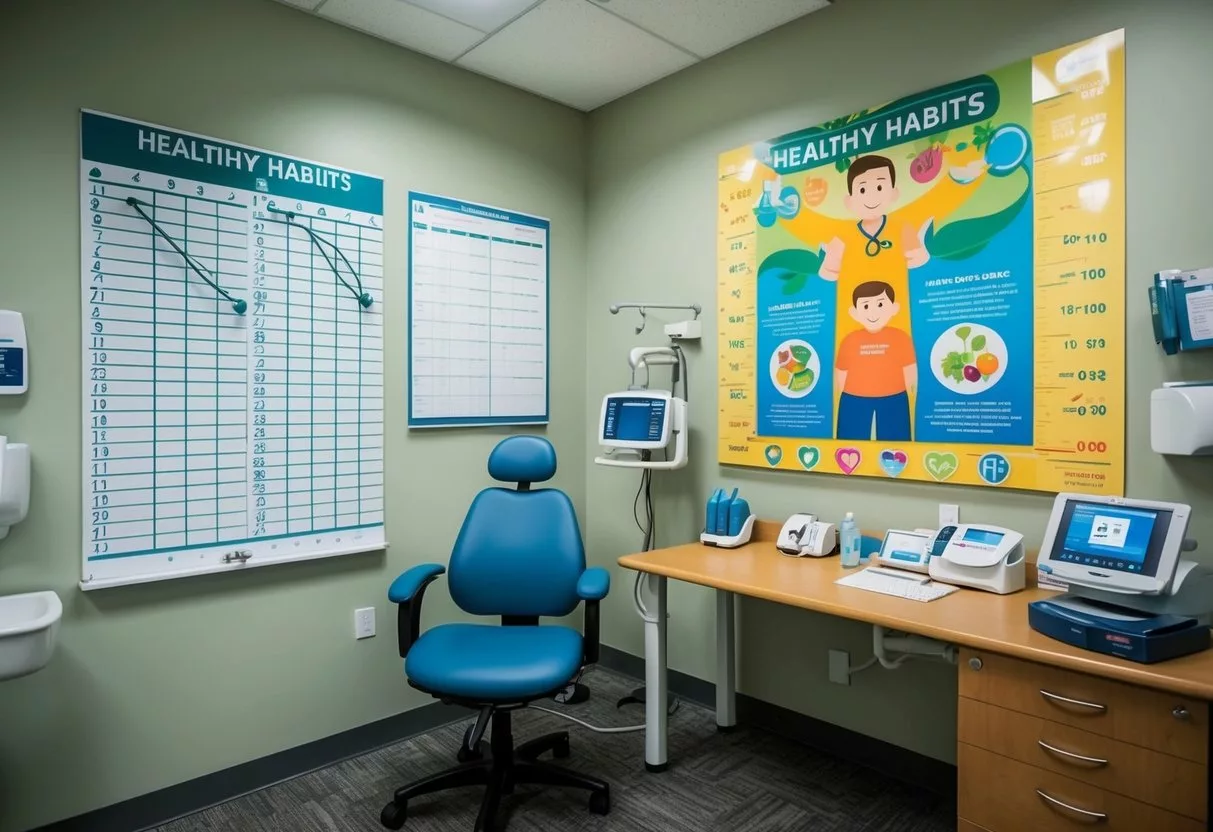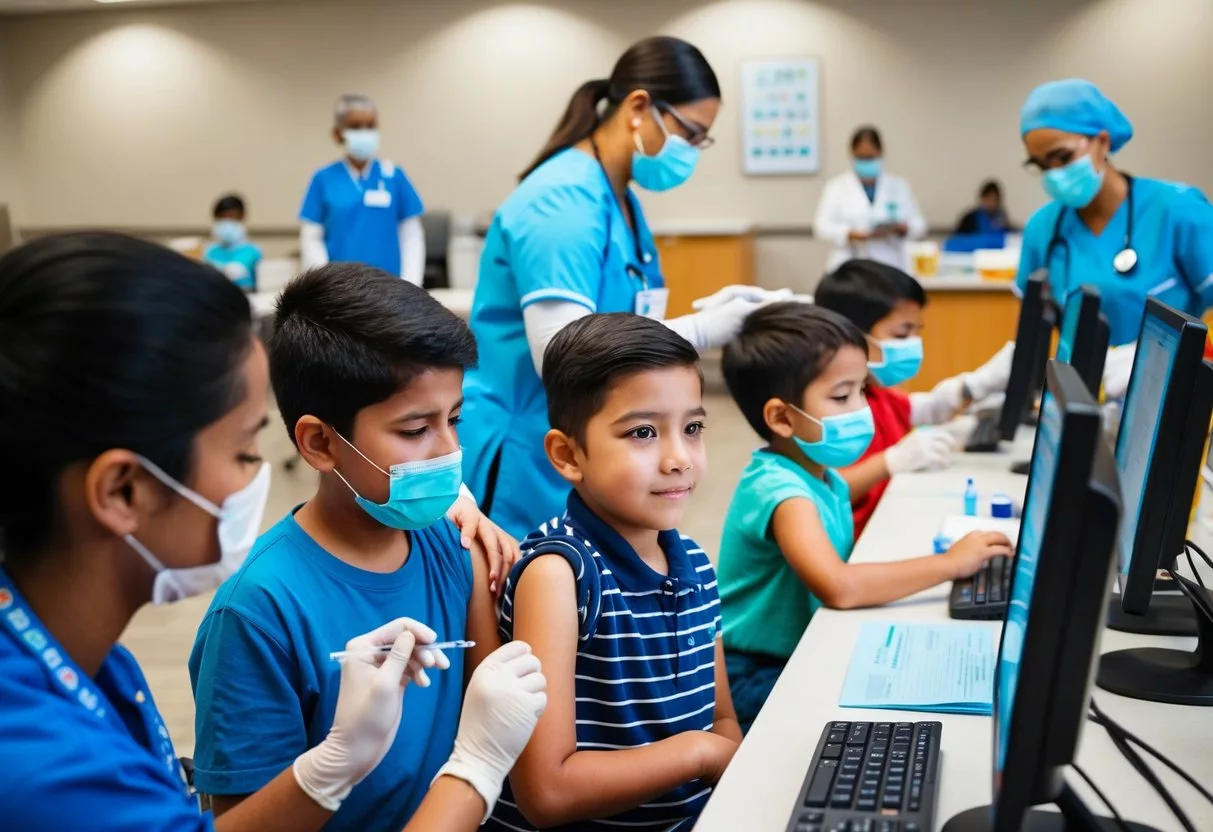Preventing adult diseases starts in childhood. Many health issues that affect adults have roots in early life. Taking steps to promote good health during childhood can have far-reaching benefits.

Healthy habits formed early in life can significantly reduce the risk of chronic diseases like heart disease, diabetes, and obesity in adulthood. Childhood cardiovascular risk factors have been linked to adult cardiovascular events. This highlights the importance of early prevention efforts.
Public health initiatives focus on promoting children’s healthy growth and development to prevent future health problems. These efforts include encouraging good nutrition, regular physical activity, and addressing mental health from a young age. By tackling health issues early, we can help kids grow into healthier adults.
Key Takeaways
- Early prevention efforts can reduce adult disease risks.
- Healthy childhood habits support lifelong well-being.
- Public health initiatives play a key role in disease prevention.
Establishing a Baseline of Childhood Health

Early health assessments and preventive care play key roles in setting the foundation for lifelong wellness. Regular check-ups and screenings help catch potential issues before they become serious problems.
Importance of Early Health Assessments
Early health assessments are crucial for tracking a child’s growth and development. Growth charts help doctors spot any concerning trends. These charts track height, weight, and head size over time.
Regular check-ups allow doctors to:
- Monitor physical growth
- Check vision and hearing
- Screen for developmental delays
- Update vaccinations
Early assessments can catch issues like:
• Nutritional deficiencies
• Hearing or vision problems
• Cognitive delays
Addressing these early on leads to better outcomes. It sets kids up for success in school and life.
Role of Pediatricians in Preventive Care
Pediatricians are key players in preventive care for children. They provide regular check-ups to track growth and development.
These doctors:
- Give vaccines to prevent illness
- Screen for health issues
- Offer advice on nutrition and safety
Pediatricians educate families on healthy habits. They teach about proper diet, exercise, and sleep. This helps prevent issues like obesity and diabetes.
They also screen for mental health concerns. Early detection of conditions like anxiety or ADHD can lead to timely treatment. This improves a child’s quality of life and future prospects.
Childhood Nutrition and Its Long-Term Effects

Good nutrition during childhood shapes future health. It can prevent diseases and promote well-being in adulthood. Kids need the right foods to grow strong and stay healthy.
Balanced Diet for Children
A balanced diet for kids includes fruits, vegetables, whole grains, lean proteins, and dairy. These foods give children the nutrients they need to grow and develop properly.
Kids should eat a variety of colors on their plates. This helps ensure they get different vitamins and minerals. For example, orange foods like carrots have vitamin A, while green veggies have iron and folate.
Protein is important for building strong muscles and bones. Good sources include lean meats, fish, eggs, and beans. Whole grains provide energy and fiber. They help kids feel full and keep their digestive systems healthy.
Limiting added sugars and unhealthy fats is key. Too much of these can lead to health problems later in life. Instead, focus on healthy fats from foods like avocados and nuts.
Avoiding Childhood Obesity
Childhood obesity is a growing problem. It can lead to many health issues in adulthood. These include heart disease, diabetes, and joint problems.
To prevent obesity, kids need to eat healthy and stay active. Balanced meals and regular exercise are crucial. Parents should set a good example by making healthy choices too.
Portion control is important. Kids should eat until they feel satisfied, not stuffed. Using smaller plates can help with this. It’s also good to limit sugary drinks and snacks.
Encourage kids to play outside and join sports teams. This helps them stay fit and have fun. Limiting screen time is also key. Too much TV or video games can lead to a sedentary lifestyle.
Regular check-ups with a doctor can help track a child’s growth. This way, any weight issues can be caught and addressed early.
Physical Activity and Its Role in Disease Prevention

Regular exercise and reducing sedentary time are key ways to prevent many adult diseases starting in childhood. Physical activity helps build strong bones and muscles, improves heart health, and reduces the risk of obesity.
Regular Exercise Guidelines for Children
Kids need at least 60 minutes of moderate to vigorous physical activity every day. This can include:
- Playing tag or other active games
- Riding bikes
- Swimming
- Team sports like soccer or basketball
Aerobic activities should make up most of the 60 minutes. Kids also need muscle-strengthening exercises 3 days a week, like:
- Climbing on playground equipment
- Doing push-ups or sit-ups
- Jumping rope
Bone-strengthening activities 3 days a week are important too. These include running, jumping, and gymnastics.
Parents can help by being active with their kids and limiting screen time. Schools should provide daily physical education and recess.
Reducing Sedentary Behavior
Too much sitting is bad for health, even for active kids. Sedentary behavior increases the risk of obesity, diabetes, and heart disease.
Ways to cut down on sedentary time:
- Limit recreational screen time to no more than 2 hours a day
- Take active breaks during homework time
- Walk or bike to school when possible
- Stand or move during TV commercials
- Use a standing desk for some schoolwork
Parents can set a good example by limiting their own screen time. Family activities like after-dinner walks get everyone moving.
Schools can help by providing standing desks and movement breaks during class. Active video games are better than sitting ones.
Mental Health Awareness from an Early Age

Mental health issues can start early in life. Recognizing signs and promoting well-being in children is key. This helps prevent problems later on.
Identifying Signs of Stress and Depression
Depression affects about 7% of young people. Parents and teachers should watch for these signs:
• Sudden changes in mood or behavior
• Loss of interest in activities
• Problems with sleep or eating
• Difficulty concentrating
• Physical complaints without clear cause
Early detection allows for timely help. If signs persist for more than two weeks, it’s important to talk to a doctor.
Kids may not always say how they feel. Adults should create a safe space for open talks about emotions. Regular check-ins can help spot issues early.
Promoting Emotional Well-being
Building good mental health starts young. Here are ways to support children’s emotional growth:
• Encourage physical activity and outdoor play
• Teach coping skills for stress
• Foster strong family and friend connections
• Limit screen time and promote face-to-face interaction
• Ensure enough sleep and a balanced diet
Schools can play a big role in mental health promotion. They can offer programs on:
- Emotional intelligence
- Conflict resolution
- Mindfulness techniques
These skills help kids handle life’s ups and downs better. They build resilience for future challenges.
Parents should model good mental health habits. This includes managing their own stress and seeking help when needed.
Addressing Specific Risk Factors in Childhood

Early prevention of adult diseases starts with tackling key risk factors in childhood. Two major concerns are the rise of type 2 diabetes and hypertension in young people. Taking action early can help avoid serious health issues later in life.
Preventing Type 2 Diabetes
Type 2 diabetes in children is linked to obesity and lack of physical activity. To reduce risk:
- Encourage healthy eating habits with plenty of fruits and vegetables
- Limit sugary drinks and processed foods
- Promote regular exercise, aiming for 60 minutes daily
- Monitor blood sugar levels in at-risk children
Insulin resistance often precedes type 2 diabetes. Doctors may recommend metformin for children with insulin resistance to delay or prevent diabetes onset.
Regular check-ups can catch early signs of diabetes. If a child shows symptoms like increased thirst or frequent urination, prompt testing is crucial.
Managing Childhood Hypertension
High blood pressure in children can lead to heart problems later. To manage hypertension:
- Reduce salt intake to less than 6 grams per day
- Encourage physical activity for at least an hour daily
- Maintain a healthy weight through diet and exercise
- Limit screen time to promote active lifestyles
Regular blood pressure checks are important, especially for overweight children or those with a family history of hypertension. If lifestyle changes don’t help, doctors may prescribe medication.
Stress management techniques like deep breathing or meditation can also help lower blood pressure in children.
Chronic Conditions and Growth Monitoring

Tracking health in childhood is key for preventing adult diseases. Proper management of chronic conditions and careful growth monitoring can have lifelong benefits.
Asthma and Allergy Management
Asthma is one of the most common chronic conditions in children. Early diagnosis and treatment are crucial. Doctors may prescribe inhaled corticosteroids to reduce airway inflammation.
Regular check-ups help adjust medications as needed. Identifying and avoiding triggers is important. Common triggers include:
- Pollen
- Dust mites
- Pet dander
- Cold air
Teaching children proper inhaler technique improves medication effectiveness. An asthma action plan helps families manage symptoms and know when to seek emergency care.
Allergy testing can identify specific triggers. Immunotherapy may be an option for some children to reduce sensitivity to allergens over time.
Tracking Growth to Prevent Stunting and Obesity
Regular growth monitoring helps detect issues early. Doctors plot height, weight, and body mass index (BMI) on growth charts at each visit.
Stunting affects normal activities and may require extensive care. Signs of stunting include:
- Height below 3rd percentile for age
- Slow growth rate
- Delayed puberty
Obesity in childhood increases risk of adult health problems. BMI above the 95th percentile indicates obesity. Healthy habits to prevent obesity include:
- Balanced diet rich in fruits and vegetables
- Limited sugary drinks and processed foods
- Regular physical activity
- Adequate sleep
Early intervention for abnormal growth patterns improves long-term outcomes. A team approach involving doctors, dietitians, and families is most effective.
Health Education and Promotion in Schools

Schools play a key role in teaching kids about health. They work with health groups to add important topics to lessons. This helps children learn how to stay healthy as they grow up.
Integrating Health Topics into Curriculum
Health education fits into many school subjects. Teachers can add health facts to math, science, and reading lessons. For example, students might:
- Count calories in a math class
- Learn about germs in science
- Read stories about healthy habits
Schools also have special health classes. These cover topics like:
• Eating well
• Exercising
• Avoiding drugs and alcohol
• Mental health
Using fun activities helps kids remember what they learn. Games, videos, and group projects make health lessons more exciting.
Collaboration with Public Health Organizations
Schools team up with health groups to teach kids even more. These groups include:
- Local health departments
- Hospitals
- Community clinics
They send experts to talk to students. The experts share real-world knowledge about staying healthy.
Health screenings are another way schools and health groups work together. Nurses might check students’:
• Vision
• Hearing
• Weight
This helps catch health issues early. Schools can then help kids get the care they need.
Public health groups also give schools tools to teach health. These might be:
- Lesson plans
- Posters
- Handouts for parents
Working together, schools and health groups help kids learn to make good choices.
Disease Surveillance and Immunization Programs

Disease surveillance and immunization programs play a crucial role in preventing adult diseases in childhood. These programs track disease spread and ensure kids get needed vaccines. They help stop outbreaks before they start.
Vaccine-Preventable Diseases
Childhood vaccination has greatly reduced illness and death from many diseases. Vaccines protect against polio, measles, rubella, and other threats.
The Centers for Disease Control and Prevention (CDC) sets U.S. vaccine schedules. These cover shots for kids and adults. Doctors follow these guides to give the right vaccines at the right times.
New vaccines get added as they’re developed. For example, the CDC added shots for chickenpox, hepatitis A, and pneumococcal disease between 1996-2023.
Data Collection and Analysis
Disease tracking helps measure how well vaccines work. It shows changes in disease patterns. This data helps update vaccine schedules when needed.
Health workers collect info on disease cases. They look at:
- Who got sick
- Where outbreaks happened
- How many people were affected
Experts analyze this data. They use it to spot trends and risks. This helps them respond quickly to outbreaks.
Tracking also shows vaccination rates. Low rates in an area can mean more risk of outbreaks. Health officials use this info to boost vaccine efforts where needed.
Social Determinants of Health in Childhood

Social factors play a big role in kids’ health. Where children live, learn, and play affects their well-being now and in the future.
Poverty and Access to Health Care
Kids in poor families often face health issues. They may not get enough food or live in safe homes. Poor children are more likely to be obese. This can lead to health problems as adults.
Many poor families can’t afford doctor visits. Even with health insurance, some struggle to pay for care. This means kids may not get check-ups or vaccines on time.
Public health programs try to help. They offer free or low-cost care for kids in need. But not all families know about these services.
The Impact of Education on Health Outcomes
A good education helps kids stay healthy. Schools teach about nutrition and exercise. Kids learn how to make smart health choices.
Children who do well in school often have better health as adults. They may get jobs with health insurance. They also tend to earn more money, which helps them afford good food and housing.
Some schools offer health services. This can include:
- Vision and hearing tests
- Dental check-ups
- Mental health support
These programs help catch health issues early. This is key for kids with disabilities who may need extra care.
Preventive Measures and Chronic Disease Management

Early interventions in childhood can greatly reduce adult disease risks. Focusing on key areas like heart health and metabolic factors is crucial for long-term wellness.
Cardiovascular Disease Prevention
Heart disease is a leading cause of death worldwide. Preventing it starts in childhood. Key steps include:
• Regular physical activity
• Healthy diet low in saturated fats
• Maintaining a healthy weight
• Not smoking
Doctors should check kids’ blood pressure regularly. High readings need follow-up. Family history matters too. Kids with relatives who had early heart issues may need extra screening.
Schools can help by offering healthy lunches and PE classes. Parents can set a good example at home. Small changes like taking walks together can make a big difference.
Managing Dyslipidemia and Metabolic Syndrome
Dyslipidemia means unhealthy levels of fats in the blood. It’s linked to metabolic syndrome. This group of conditions raises the risk of heart disease and diabetes.
Signs to watch for include:
- High blood pressure
- High blood sugar
- Excess belly fat
- Low “good” cholesterol (HDL)
Early detection is key. Doctors may test at-risk kids’ blood lipids. Treatment usually starts with lifestyle changes. This means eating better and moving more.
In some cases, medication might be needed. But it’s not common in kids. The goal is to prevent problems before they start. Regular check-ups can catch issues early.
Promoting Lifelong Health and Longevity

Early choices and habits shape our health as we age. Good nutrition and exercise in childhood can lead to better health and longer life as adults.
Impact of Early Lifestyle Choices on Adult Morbidity
Choices made in childhood can affect health for years to come. Early childhood programs boost adult health. Kids who eat well and stay active tend to be healthier adults.
Poor diet and lack of exercise in youth can raise risks later. These include:
- Heart disease
- Type 2 diabetes
- Some cancers
Healthy habits started young can lower these risks. Teaching kids to eat fruits and veggies is key. Regular physical activity matters too.
Parents and schools play big roles. They can offer healthy foods and encourage play. This helps set kids up for better long-term health.
Strategies for Increasing Life Expectancy
Small changes can add up to longer, healthier lives. Here are some key tips:
- Eat a balanced diet rich in fruits and veggies
- Exercise regularly
- Don’t smoke
- Limit alcohol intake
- Get enough sleep
Good nutrition across the lifespan is vital for healthy aging. A diet high in plants and low in processed foods helps. It can cut risks of heart disease and some cancers.
Regular check-ups catch health issues early. This allows for quicker treatment. Vaccines also prevent many deadly diseases.
Stress management is crucial too. Meditation, yoga, or hobbies can help. Strong social ties also boost health and longevity.
Frequently Asked Questions

Childhood health habits shape adult well-being. Good nutrition, vaccinations, exercise, and hygiene are key. Early detection of illnesses can prevent future problems.
How can childhood nutrition influence long-term health and adult disease prevention?
A balanced diet in childhood helps prevent adult diseases. Kids who eat fruits, vegetables, and whole grains are less likely to get heart disease later. Limiting sugar and unhealthy fats can lower the risk of diabetes and obesity.
Good eating habits formed early tend to stick. Children who learn to enjoy healthy foods often keep eating well as adults. This can lead to better health over a lifetime.
What vaccination schedule is recommended to prevent common childhood infectious diseases?
The CDC provides a detailed vaccination schedule for children. Vaccines protect against diseases like measles, polio, and whooping cough. Most shots are given before age 2, with boosters later.
Following this schedule is crucial. It ensures kids get the right protection at the right time. Vaccines are safe and effective at preventing serious illnesses.
What role does physical activity play in preventing chronic diseases from developing in children?
Regular exercise helps kids stay at a healthy weight. This lowers their risk of obesity, diabetes, and heart problems as adults. Active children often grow into active adults.
Physical activity also builds strong bones and muscles. It improves mood and sleep too. The goal is 60 minutes of play or exercise each day for kids.
Which pediatric illnesses are most commonly linked to long-term adult health issues?
Childhood obesity can lead to adult diabetes and heart disease. Asthma in kids may persist into adulthood. Untreated infections can cause lasting organ damage.
Some childhood cancers may affect health later in life. Mental health issues starting young can continue in adulthood. Early detection and treatment of these conditions is important.
What are effective strategies for increasing hygiene awareness among children to prevent diseases?
Teaching proper handwashing is key. Kids should learn to wash for 20 seconds with soap and water. Making it fun with songs or games can help.
Showing children how germs spread can make hygiene more real to them. Using glitter or washable paint as “germs” in activities works well. Regular reminders and praise for good habits reinforce learning.
How does early detection and management of childhood illnesses impact disease prevention in adulthood?
Catching health issues early in kids can prevent bigger problems later. Regular check-ups help find concerns before they get serious. Treating conditions like high blood pressure in children can stop heart disease in adults.
Early intervention for developmental issues can improve long-term outcomes. Managing chronic conditions from a young age leads to better health as an adult. Screenings and vaccinations in childhood protect against many adult diseases.